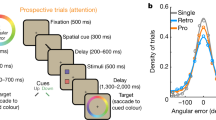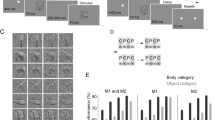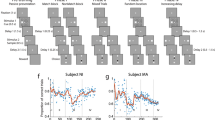Abstract
Our ability to learn a wide range of behavioral tasks is essential for responding appropriately to sensory stimuli according to behavioral demands, but the underlying neural mechanism has been rarely examined by neurophysiological recordings in the same subjects across learning. To understand how learning new behavioral tasks affects neuronal representations, we recorded from posterior parietal cortex (PPC) before and after training on a visual motion categorization task. We found that categorization training influenced cognitive encoding in PPC, with a marked enhancement of memory-related delay-period encoding during the categorization task that was absent during a motion discrimination task before categorization training. In contrast, the prefrontal cortex (PFC) exhibited strong delay-period encoding during both discrimination and categorization tasks. This reveals a dissociation between PFC's and PPC's roles in working memory, with general engagement of PFC across multiple tasks, in contrast with more task-specific mnemonic encoding in PPC.
This is a preview of subscription content, access via your institution
Access options
Subscribe to this journal
Receive 12 print issues and online access
$209.00 per year
only $17.42 per issue
Buy this article
- Purchase on Springer Link
- Instant access to full article PDF
Prices may be subject to local taxes which are calculated during checkout







Similar content being viewed by others
References
Engel, T.A., Chaisangmongkon, W., Freedman, D.J. & Wang, X.-J. Choice-correlated activity fluctuations underlie learning of neuronal category representation. Nat. Commun. 6, 6454 (2015).
Freedman, D.J., Riesenhuber, M., Poggio, T. & Miller, E.K. Categorical representation of visual stimuli in the primate prefrontal cortex. Science 291, 312–316 (2001).
Freedman, D.J. & Assad, J.A. Experience-dependent representation of visual categories in parietal cortex. Nature 443, 85–88 (2006).
Freedman, D.J., Riesenhuber, M., Poggio, T. & Miller, E.K. A comparison of primate prefrontal and inferior temporal cortices during visual categorization. J. Neurosci. 23, 5235–5246 (2003).
Goodwin, S.J., Blackman, R.K., Sakellaridi, S. & Chafee, M.V. Executive control over cognition: stronger and earlier rule-based modulation of spatial category signals in prefrontal cortex relative to parietal cortex. J. Neurosci. 32, 3499–3515 (2012).
Crowe, D.A. et al. Prefrontal neurons transmit signals to parietal neurons that reflect executive control of cognition. Nat. Neurosci. 16, 1484–1491 (2013).
Ferrera, V.P., Yanike, M. & Cassanello, C. Frontal eye field neurons signal changes in decision criteria. Nat. Neurosci. 12, 1458–1462 (2009).
Fitzgerald, J.K., Freedman, D.J. & Assad, J.A. Generalized associative representations in parietal cortex. Nat. Neurosci. 14, 1075–1079 (2011).
Swaminathan, S.K. & Freedman, D.J. Preferential encoding of visual categories in parietal cortex compared with prefrontal cortex. Nat. Neurosci. 15, 315–320 (2012).
Freedman, D.J., Riesenhuber, M., Poggio, T. & Miller, E.K. Experience-dependent sharpening of visual shape selectivity in inferior temporal cortex. Cereb. Cortex 16, 1631–1644 (2006).
Sigala, N. & Logothetis, N.K. Visual categorization shapes feature selectivity in the primate temporal cortex. Nature 415, 318–320 (2002).
Vogels, R. Categorization of complex visual images by rhesus monkeys. Part 2: single-cell study. Eur. J. Neurosci. 11, 1239–1255 (1999).
De Baene, W., Ons, B., Wagemans, J. & Vogels, R. Effects of category learning on the stimulus selectivity of macaque inferior temporal neurons. Learn. Mem. 15, 717–727 (2008).
Fitzgerald, J.K., Swaminathan, S.K. & Freedman, D.J. Visual categorization and the parietal cortex. Front. Integr. Neurosci. 6, 18 (2012).
D'Esposito, M. & Postle, B.R. The cognitive neuroscience of working memory. Annu. Rev. Psychol. 66, 115–142 (2015).
Miller, E.K. & Cohen, J.D. An integrative theory of prefrontal cortex function. Annu. Rev. Neurosci. 24, 167–202 (2001).
Curtis, C.E. Prefrontal and parietal contributions to spatial working memory. Neuroscience 139, 173–180 (2006).
Lara, A.H. & Wallis, J.D. Executive control processes underlying multi-item working memory. Nat. Neurosci. 17, 876–883 (2014).
Goldman-Rakic, P.S. Cellular basis of working memory. Neuron 14, 477–485 (1995).
Sreenivasan, K.K., Curtis, C.E. & D'Esposito, M. Revisiting the role of persistent neural activity during working memory. Trends Cogn. Sci. 18, 82–89 (2014).
Wang, X.-J. Synaptic reverberation underlying mnemonic persistent activity. Trends Neurosci. 24, 455–463 (2001).
Swaminathan, S.K., Masse, N.Y. & Freedman, D.J. A comparison of lateral and medial intraparietal areas during a visual categorization task. J. Neurosci. 33, 13157–13170 (2013).
Crowe, D.A., Averbeck, B.B. & Chafee, M.V. Rapid sequences of population activity patterns dynamically encode task-critical spatial information in parietal cortex. J. Neurosci. 30, 11640–11653 (2010).
Meyers, E.M., Freedman, D.J., Kreiman, G., Miller, E.K. & Poggio, T. Dynamic population coding of category information in inferior temporal and prefrontal cortex. J. Neurophysiol. 100, 1407–1419 (2008).
Zaksas, D. & Pasternak, T. Directional signals in the prefrontal cortex and in area MT during a working memory for visual motion task. J. Neurosci. 26, 11726–11742 (2006).
Law, C.-T. & Gold, J.I. Neural correlates of perceptual learning in a sensory-motor, but not a sensory, cortical area. Nat. Neurosci. 11, 505–513 (2008).
Freedman, D.J. & Assad, J.A. A proposed common neural mechanism for categorization and perceptual decisions. Nat. Neurosci. 14, 143–146 (2011).
Rishel, C.A., Huang, G. & Freedman, D.J. Independent category and spatial encoding in parietal cortex. Neuron 77, 969–979 (2013).
Pasternak, T., Lui, L.L. & Spinelli, P.M. Unilateral prefrontal lesions impair memory-guided comparisons of contralateral visual motion. J. Neurosci. 35, 7095–7105 (2015).
Koenigs, M., Barbey, A.K., Postle, B.R. & Grafman, J. Superior parietal cortex is critical for the manipulation of information in working memory. J. Neurosci. 29, 14980–14986 (2009).
Berryhill, M.E., Chein, J. & Olson, I.R. At the intersection of attention and memory: the mechanistic role of the posterior parietal lobe in working memory. Neuropsychologia 49, 1306–1315 (2011).
Chafee, M.V. & Goldman-Rakic, P.S. Matching patterns of activity in primate prefrontal area 8a and parietal area 7ip neurons during a spatial working memory task. J. Neurophysiol. 79, 2919–2940 (1998).
Fanini, A. & Assad, J.A. Direction selectivity of neurons in the macaque lateral intraparietal area. J. Neurophysiol. 101, 289–305 (2009).
Ibos, G. & Freedman, D.J. Dynamic integration of task-relevant visual features in posterior parietal cortex. Neuron 83, 1468–1480 (2014).
Born, R.T. & Bradley, D.C. Structure and function of visual area MT. Annu. Rev. Neurosci. 28, 157–189 (2005).
Colby, C.L., Duhamel, J.R. & Goldberg, M.E. Ventral intraparietal area of the macaque: anatomic location and visual response properties. J. Neurophysiol. 69, 902–914 (1993).
Cook, E.P. & Maunsell, J.H.R. Attentional modulation of behavioral performance and neuronal responses in middle temporal and ventral intraparietal areas of macaque monkey. J. Neurosci. 22, 1994–2004 (2002).
Lewis, J.W. & Van Essen, D.C. Corticocortical connections of visual, sensorimotor, and multimodal processing areas in the parietal lobe of the macaque monkey. J. Comp. Neurol. 428, 112–137 (2000).
Mendoza-Halliday, D., Torres, S. & Martinez-Trujillo, J.C. Sharp emergence of feature-selective sustained activity along the dorsal visual pathway. Nat. Neurosci. 17, 1255–1262 (2014).
Antzoulatos, E.G. & Miller, E.K. Differences between neural activity in prefrontal cortex and striatum during learning of novel abstract categories. Neuron 71, 243–249 (2011).
Asaad, W.F., Rainer, G. & Miller, E.K. Neural activity in the primate prefrontal cortex during associative learning. Neuron 21, 1399–1407 (1998).
Pasupathy, A. & Miller, E.K. Different time courses of learning-related activity in the prefrontal cortex and striatum. Nature 433, 873–876 (2005).
Messinger, A., Squire, L.R., Zola, S.M. & Albright, T.D. Neuronal representations of stimulus associations develop in the temporal lobe during learning. Proc. Natl. Acad. Sci. USA 98, 12239–12244 (2001).
Cromer, J.A., Roy, J.E. & Miller, E.K. Representation of multiple, independent categories in the primate prefrontal cortex. Neuron 66, 796–807 (2010).
Roy, J.E., Riesenhuber, M., Poggio, T. & Miller, E.K. Prefrontal cortex activity during flexible categorization. J. Neurosci. 30, 8519–8528 (2010).
Asaad, W.F., Santhanam, N., McClellan, S. & Freedman, D.J. High-performance execution of psychophysical tasks with complex visual stimuli in MATLAB. J. Neurophysiol. 109, 249–260 (2013).
Meyers, E.M., Qi, X.-L. & Constantinidis, C. Incorporation of new information into prefrontal cortical activity after learning working memory tasks. Proc. Natl. Acad. Sci. USA 109, 4651–4656 (2012).
Chang, C. & Lin, C. LIBSVM: a library for support vector machines. ACM Trans. Intell. Syst. Technol. 2, 1–27 (2012).
Acknowledgements
The authors thank N. Santhanam, R. Kharkar and M. Rose for assistance with animal training, J. Hodnefield for expert behavioral and experimental assistance, S. Thomas for expert technical assistance, C. Gray for technical and surgical assistance, and the staff of The University of Chicago Animal Resources Center for expert veterinary assistance. We also thank J. Assad, S. Bensmaia, N. Brunel, J. Chaisangmongkon, T. Engel, G. Ibos and K. Mohan for valuable input and/or comments on an earlier version of this manuscript. This work was supported by a grants from the US National Institutes of Health (R01MH092927 to X.-J.W. and D.J.F. and R01EY019041 to D.J.F.), and NRSA MH097428 (A.S.). Additional support was provided by a McKnight Scholar award, the Alfred P. Sloan Foundation, NSF CAREER award 0955640, The Brain Research Foundation (D.J.F.) and R01-MH062349 (X.-J.W.).
Author information
Authors and Affiliations
Contributions
D.J.F., A.S., N.Y.M. and X.-J.W. designed the experiments. A.S. and N.Y.M. trained the animals, performed all of the neurophysiological recordings, performed all of the data analysis and assisted with writing the manuscript. D.J.F. supervised the experimental work, assisted with animal training, neurophysiological recordings, data analysis and wrote the manuscript. X.-J.W. assisted in data analysis and edited the manuscript.
Corresponding author
Ethics declarations
Competing interests
The authors declare no competing financial interests.
Integrated supplementary information
Supplementary Figure 1 Pre-recording behavioral performance.
Performance is shown for the last seven days of training prior to neuronal recordings for the DMS and DMC tasks. (a) The monkeys’ average DMS performance (proportion reported as non-match) is shown as a function of sample-test difference. The gray line is a sigmoid curve fit to the behavioral data. Dashed black line indicates chance performance. Error bars indicate SEM for sample-test differences that were presented on more than one session. The circular points show behavioral performance for sample-test differences tested in only one session. The mean number of presentations per sample-test difference was 127 per session. (b) The monkeys’ average DMC performance is shown as a function of sample direction. Colors correspond to the two categories and the green dashed lines correspond to the category boundary. Dashed black line indicates chance performance. Error bars indicate SEM.
Supplementary Figure 2 DMS training behavioral performance.
The monkeys’ DMS performance leading up to DMS recordings is shown as a function of training session for Monkey D (a) and Monkey H (b). The level of behavioral performance is depicted by plotting the sample-test difference at which the monkey would perform at 75% accuracy, as estimated by a sigmoid curve (1+1/(1+e-(x-a)/b)) fit to the average performance for the sample-test differences tested in each session. The first 21 (Monkey D) and 20 (Monkey H) motion-DMS training sessions were excluded because performance on 180° sample-test differences was lower than the performance threshold (as the monkey was not yet reliably differentiating between 180° non-matches).
Supplementary Figure 3 Single-neuron measures of direction and category classification.
The average time-course of direction and category selectivity for individual neurons measured by the rDSI (a) and rCTI (b) during DMS (pink curve) and DMC (green curve) tasks. The three dashed, vertical lines represent the start of the sample epoch, the end of the sample epoch, and the end of the delay epoch, respectively. Gray and black bars represent times at which classification accuracy was significantly different between the populations recorded during the two tasks (Wilcoxon rank-sum test, gray, P<0.05, black, P<0.01). Only cells that were direction selective during the sample or delay periods were used from each population. (c-f) Distributions of neurons’ rDSI (c,d) and rCTI (e,f) values during the sample (c,e) and delay (d,f) periods for direction selective cells during the indicated task epoch. Thick dashed lines indicate mean values across the population of direction selective cells during the DMS (pink) or DMC (green) tasks (rDSI, Sample: DMS µ=0.16, DMC µ=0.13; rCTI, Sample: DMS µ=-0.0015, DMC µ=0.0093; rDSI, Delay: DMS µ=0.044, DMC µ=0.038; rCTI, Delay: DMS µ=3.9x10-4, DMC µ=0.049; ***P<=0.001).
Supplementary Figure 4 Temporal stability of direction encoding in LIP.
Similar to Figure 5c, the stability of direction encoding in LIP neurons was determined by training the classifier at one time point (y axis) and testing at a second time point (x axis). Classification accuracy is indicated by the color at each x-y coordinate. (a) Direction classification accuracy during the DMS task was above chance during the sample epoch, and near chance during the delay epoch. Classification values were approximately equal for most training and test times during the sample, indicating that direction encoding was mostly stable during this epoch. (b) Direction classification accuracy during the DMC task was also above chance during the sample epoch, and near chance during the delay epoch. Similar to (a), direction encoding was mostly stable during the sample epoch.
Supplementary Figure 5 Mid-training DMC behavioral performance.
(a) The monkeys’ average DMC performance is shown as a function of sample direction. Colors correspond to the two categories and the green dashed lines correspond to the category boundary. The dashed black line indicates chance performance. Error bars indicate standard error of mean (SEM). (b–e) The monkeys’ average DMC performance during mid-training DMC (cyan) and fully-trained DMC (green) recordings is shown as a function of sample-test difference for match trials (b,c) and nonmatch trials (d,e) where sample directions were 22.5° (b,d) or 67.5° (c,e) from the boundary. Dashed black line indicates chance performance. Error bars indicate SEM.
Supplementary Figure 6 Example LIP neurons and population-level direction and category classification during the mid-training DMC task.
(a,b) Average activity evoked by 8 sample directions for two LIP neurons from the mid-training DMC task. Different traces indicate different sample directions and are colored according to their direction and category membership. The three dashed, vertical lines represent the start of the sample epoch, the end of the sample epoch, and the end of the delay epoch, respectively. Dark blue and dark red traces indicate sample directions near the middle of categories 1 and 2, respectively, while light blue and light red traces indicate sample directions near the category boundary. Both cells shown were direction and/or category selective during the sample period (one-way ANOVA, P<0.01). Neither cell was direction selective during the delay period. (c,d) The time course of direction and category selectivity in LIP during the mid-training DMC task was determined by computing classification accuracy as a function of time relative to sample onset using the (c) sample direction classifier and (d) sample category classifier. Error bars indicate SEM. The light and dark colored bars at the top of the figures indicate times at which classification accuracy was significantly above chance (light, P<0.05, dark, P<0.01, bootstrap).
Supplementary Figure 7 Monkeys Q and W DMS behavioral performance.
The monkeys’ average DMS performance is shown as a function of sample direction. The chance level of performance in the DMS task is 50%. Error bars indicate SEM.
Supplementary Figure 8 Temporal stability of direction encoding in PPC.
Similar to Figure 5c, the stability of direction encoding in PPC was determined by training the classifier at one time point (y axis) and testing at a second time point (x axis). Classification accuracy is indicated by color at each x-y coordinate. Direction classification accuracy in PPC was above chance during the sample period and near chance during the delay period. Classification accuracy was above chance only near the diagonal, indicating mostly dynamic direction encoding.
Supplementary information
Supplementary Text and Figures
Supplementary Figures 1–8 and Supplementary Table 1 (PDF 1227 kb)
Rights and permissions
About this article
Cite this article
Sarma, A., Masse, N., Wang, XJ. et al. Task-specific versus generalized mnemonic representations in parietal and prefrontal cortices. Nat Neurosci 19, 143–149 (2016). https://doi.org/10.1038/nn.4168
Received:
Accepted:
Published:
Issue Date:
DOI: https://doi.org/10.1038/nn.4168
This article is cited by
-
Category representation in primary visual cortex after visual perceptual learning
Cognitive Neurodynamics (2024)
-
Low-dimensional encoding of decisions in parietal cortex reflects long-term training history
Nature Communications (2023)
-
Evidence accumulation occurs locally in the parietal cortex
Nature Communications (2022)
-
Ensemble representations reveal distinct neural coding of visual working memory
Nature Communications (2019)
-
The role of prefrontal cortex in the control of feature attention in area V4
Nature Communications (2019)



